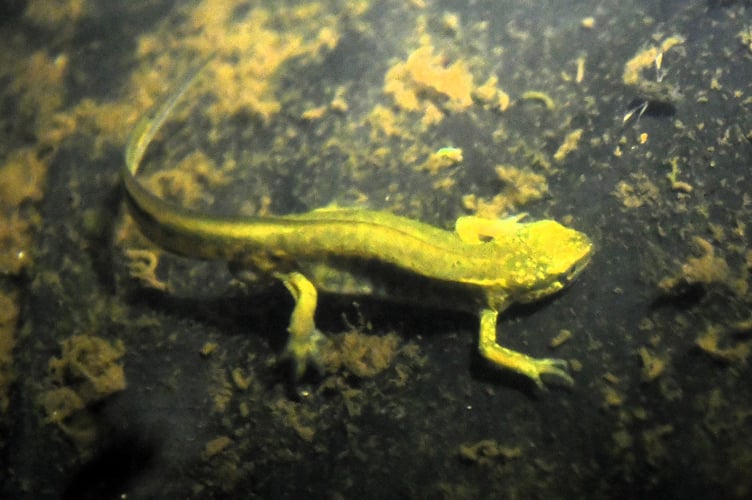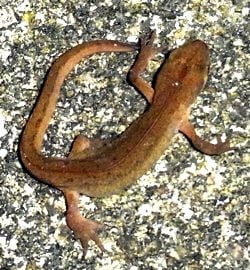WHEN nature threatens to move from the moor to take over our gardens, it can be time for drastic action, as Exmoor Natural History Society (ENHS) member GAIL CRANE discovered when flying hedgehogs invaded her garden pond.
That’s the popular nickname for Sword Rush (Junctus Ensifolius), a plant with grass-green foliage and brown seed heads resembling hedgehogs. It flourishes on the edges of ponds, and needs no encouragement to get out of hand.
As a result, our garden pond was clogged with Flying Hedgehogs.
A drawback of native plants is they are so well adapted to their surroundings that they can become a problem. This is what happened with Juncus Ensifolius.
After eight years it had formed a dense mat of root which defied all attempts at controlling it. Other plants had long since given up the battle for survival and disappeared, one by one.
The pond was in danger of following the natural progression through bog to dry land and vanishing altogether, and so drastic action was required.
-(Photo-Barry-Hitchcock).png?width=752&height=500&crop=752:500)
.png?width=752&height=500&crop=752:500)
With the help of a local gardener, we decided to clear the pond completely and begin again.
We transferred as many snails, insects and other creatures as possible to a bucket and left some of the bottom sludge in place as we weren’t sure what might be sheltering there.
Fingers were firmly crossed that there were no Flying Hedgehog seeds lurking in the mud. We then filled up the pond with rainwater from the butts and left it to settle.
So, what to plant? It had to be natives but hopefully we could find ones less troublesome than the Rush. We decided to begin with Hornwort, Fringe lily (Nymphoides Peltata), Amphibious Bistort (Persicaria amphibia) and Lesser Spearwort (Rannunculus Flammula).
The wildlife, which seemed none the worse for its short stay in the bucket, was returned to the pond. Pond skaters, water boatmen, whirlygig beetles and numerous unidentified wrigglers, quickly increased in number, and the dragonflies and damselflies soon returned to entertain us with their courtship displays.
-(Photo-Barry-Hitchcock).jpeg?width=752&height=500&crop=752:500)

One of the reasons for digging the pond in the first place was to attract frogs to eat the slugs with which the garden is heavily infested.
Sadly, though a solitary toad once took up temporary residence in the compost heap, and slow-worms nest beneath the shed, frogs have so far failed to visit.
But a surprise was in store. At the end of May, our family came to visit. My son and I were in the garden next to the pond, enjoying some rare sunshine and catching up on news, when he suddenly jumped and exclaimed, ‘Oh! I saw a newt!’
When an excited search of the pond revealed nothing, we decided he must have been mistaken until, a few days later, we discovered a tiny newt hiding near the house.
If it was indeed from our pond, it must have somehow negotiated the long flight of steep steps from the pond down to the house and also made its way up again, as next time we looked it had disappeared.
How could this tiny creature accomplish such a feat? We have since learned they are very good climbers.

.png?width=752&height=500&crop=752:500)
In the absence of frogs, I venture out most evenings after dark, armed with torch, to hunt slugs and snails. As I passed the pond one night, I shone the torch into the water and was astonished to see two tiny newts caught in the beam.
Over the next few nights, we kept a careful watch, some nights counting only a couple, on others as many as six or seven.
Were they Smooth or Palmate Newts? Though Smooth tend to be the more common of the two, Palmate are more usual on the acid soils of Exmoor.
We took photographs and sent them to the Exmoor Natural History Society experts for identification. They were definitely Palmate Newts.
The breeding season is between March and June, so they must have arrived soon after we completed the new planting. Perhaps they like the open water? As I write this, at the beginning of July, there is no sign of them.
Adults and the young efts have left to spend the rest of the year elsewhere, hopefully in the garden where they can feast on slugs, until returning to the pond next spring.
.jpeg?width=752&height=500&crop=752:500)



